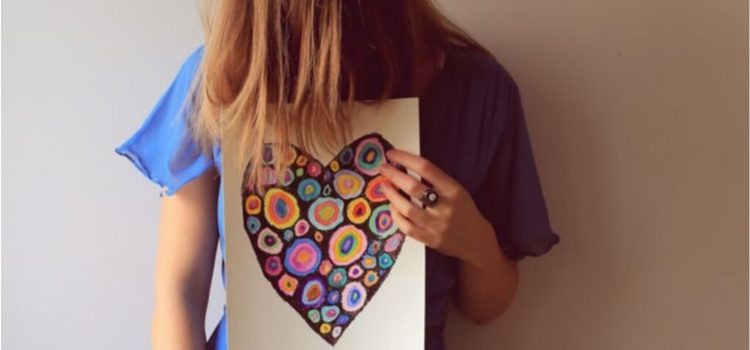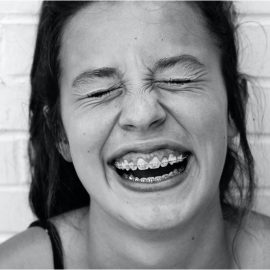

This article is an excerpt from the Shortform book guide to "Smile" by Raina Telgemeier. Shortform has the world's best summaries and analyses of books you should be reading.
Like this article? Sign up for a free trial here.
How can parents support body positivity for teens? What should you do if your child becomes hyper-focused on their appearance?
Raina Telgemeier’s graphic novel Smile sends an uplifting message: confidence comes by focusing less on appearance and more on personal interests. Her novel not only promotes body positivity for teens but also shows parents how to support their teens through adolescent struggles.
Read on to learn how to support teen body positivity, based on the first-hand advice in Smile.
Smile & Teen Body Positivity
Through her exploration of adolescence, self-consciousness, and the horrors of dental work, Raina Telgemeier sends an uplifting message in her autobiographical graphic novel Smile: that you can achieve confidence by focusing less on your appearance and more on your interests. In this article, we’ll explore some of the first-hand advice she offers for supporting body positivity for teens, based on her own coming-of-age story.
Raina’s Fixation on Her Appearance Grows
In her novel Smile, as Raina moves further into adolescence and toward the end of her sixth grade year, she’s not only growing more aware of her appearance: She’s also increasingly interested in romance. She tells one of her friends at a sleepover that she wishes cute boys liked her—but she laments that they never will, due to her nerdy braces and her stubby two front teeth.
Raina’s concerns about her stubby teeth prompt her to dwell on other aspects of her appearance. She expresses to her friends that she’s worried her stubby teeth make her look like a baby. One friend reassures her that her teeth don’t make her look like a baby—but her pigtails do. This makes Raina self-conscious about her hair. She decides to stop wearing it in pigtails so she can look older.
Research on Adolescents & Importance of Appearance
Carl Pickhardt, author of Surviving Your Child’s Adolescence, explains that it’s normal for adolescents to fixate on their appearance. Teens tend to be hyperaware of their and other people’s appearances for several reasons: 1) Their pubescent body is undergoing rapid changes, 2) they’re keen to express their identity through their appearance, and 3) their interest in romance drives their desire to look attractive. This last reason may explain why Raina feels self-conscious about her braces and stubby teeth.
Furthermore, teens are eager to distance themselves from their childhood selves so they feel more independent, like adults. This explains why Raina feels hurt by her friend’s comment about her pigtails, as well as why Raina is excited to look older by wearing earrings.
How can adults support body positivity for teens? How can they help them to navigate their feelings about their appearance so this fixation doesn’t spiral into an unhealthy obsession? Pickhardt offers the following suggestions:
Don’t dismiss their fixation on appearance as frivolous. Saying things like “looks don’t matter!” may invalidate the reality of their experience. Paying attention to appearance is a normal, important way for teens to express their developing identities and navigate social relationships.
Encourage them to improve their appearance in positive or harmless ways. Trying out different styles of clothing and using facewash that reduces acne won’t harm them. However, if you notice the teen engaging in unhealthy behaviors, such as excessive dieting to lose weight, it could be a sign they have an eating disorder and need professional help.
Encourage them to appreciate their other strengths. Reminding them that they’re valuable in other ways beyond appearance prevents them from relying on their looks for their sense of self-worth. For instance, you can praise them for their commitment to their hobbies, their inspiring goals, and the nurturing relationships they have with their friends.
Raina’s Mom Stands Up for Her
While Raina struggles with her confidence, one instance prompts her mom to provide an inspiring example of confidence. During a dental appointment, Raina’s dentist proceeds to treat her teeth before her anesthetic fully kicks in, causing Raina to faint when the appointment is over. Her mom stands up for Raina’s needs by passionately scolding the dentist. On their car ride home, Raina gazes admiringly at her mom and tells her that what she did was cool.
(Shortform note: Raina’s mom provides her with a model of confidence instead of directly coaching her daughter on how to be more confident—this is also a great example of how to demonstrate body positivity for teens. Experts on parenting and adolescent psychology might describe this as an effective approach because ample research reveals that teens thrive when they have autonomy over their own lives and parents can serve as powerful role models for teens’ behavior. Raina may have resisted if her mom noticed she was under-confident and provided her with unsolicited advice on behaving confidently as this approach would undermine Raina’s autonomy over the situation. Meanwhile, it’s possible that Raina’s mom’s indirect approach—modeling confidence—left a more positive impression on her daughter.)
Raina Reflects on Her Friendships, Appearance, and Confidence
Towards the end of ninth grade, Raina reflects that she was unhappy in her teen years because she lacked body positivity and allowed her concerns about her appearance to dictate her feelings. By contrast, she’s happier now because she involves herself in activities that interest her, such as choir, art, and student council. She points out that her commitment to her hobbies sets off a positive feedback cycle: Her success with these activities makes her like herself more, which makes her more confident—and her confidence attracts new friends, which makes her even more confident.
The final page of the book highlights Raina’s newfound confidence. While she’s at a school dance with her friends, they snap a picture together in a photo booth. In the picture, Raina smiles—a wide, genuine smile.
| Tips for Improving Teens’ Body Positivity and Happiness Raina’s confidence and happiness improve not long after she gets her braces off—but she doesn’t attribute her newfound confidence to the removal of her braces, as we might expect. Instead, Raina attributes her newfound confidence to her choices—specifically, her choices to befriend nicer people, pursue hobbies that interest her, and focus less on her appearance. Research reflects Raina’s experience by suggesting that removing your braces doesn’t necessarily improve your happiness. One study followed close to 500 people from age 13 to 30. Researchers compared whether people who had worn braces in their teens were now happier than those who hadn’t. They found that there was no connection between having worn braces and feeling happy. The researchers concluded that other factors must dictate a person’s happiness. So, outside of supporting teens’ body positivity, what other factors can boost confidence and happiness? Some experts claim that the top factor that determines your happiness and well-being is belonging to a community. When you belong to a community of people who trust and support you, you enjoy your daily life more and you’re more resilient due to the care they provide. Furthermore, experts emphasize that belonging to a supportive community improves your quality of life even more than putting effort into self-improvement (such as improving your appearance or maximizing your productivity). Raina’s experience toward the end of ninth grade reflects and supports this research. The positive feedback cycle she describes—in which confidence improves her social connections, which further improves her confidence—is a testament to the power of belonging to a community. The new friends with whom she forms a community support her (such as when they compliment her on her looks) and join her in community activities (such as student council). |

———End of Preview———
Like what you just read? Read the rest of the world's best book summary and analysis of Raina Telgemeier's "Smile" at Shortform.
Here's what you'll find in our full Smile summary:
- An autobiographical novel of one middle schooler's traumatic experience
- The self-consciousness that comes with having braces as a child
- Tips for parents whose children are struggling with coming of age







I would love to do now I’d be a woman I’d really like to do women’s body positivity people are so cot up in the world of celebrities. And that has to stop they have the money to what they want we should be all happy in our skin! Thank you for this well enjoyed.